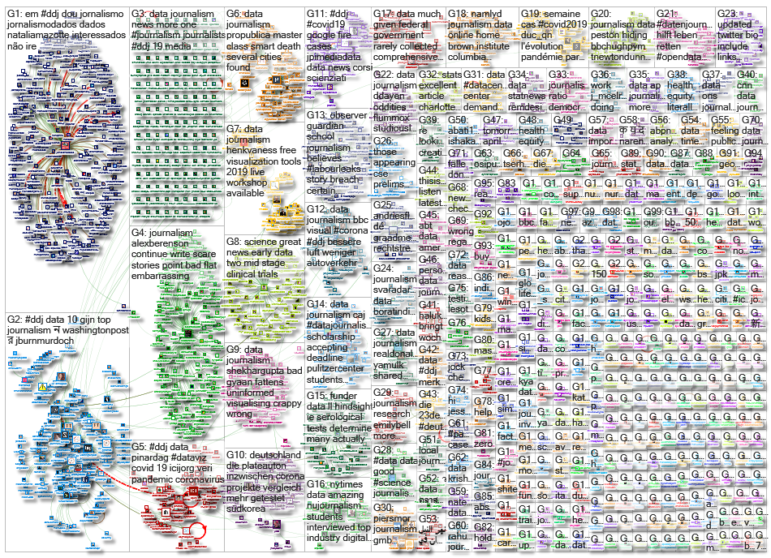

Data Journalism Top 10: Bill Gates Conspiracies, COVID-19 Excess Mortality, Home Deaths Spike, Test Kits
Misinformation has grown ubiquitous during the COVID-19 pandemic, so much so that World Health Organization Director-General Tedros Adhanom Ghebreyesus proclaimed: “We’re not just fighting an epidemic; we’re fighting an infodemic.” Microsoft co-founder Bill Gates has emerged as a favorite target of disinformation actors, according to an article in The New York Times, that we discovered through our NodeXL #ddj mapping from April 13 to 19. We also found The Economist and ProPublica examining the true impact of the pandemic by looking into “excess mortalities” such as home deaths, the Associated Press releasing and updating a coronavirus public dataset for the United States, and the International Consortium of Investigative Journalists talking about the limitations of current COVID-19 data.
Coronavirus Conspiracies Circling Bill Gates
Microsoft co-founder Bill Gates is the target of an explosion of conspiracy theories surrounding the coronavirus outbreak. This piece by The New York Times looking into the attacks against Gates unleashed by anti-vaccinators, conspiracy theorists, and right-wing pundits is peppered with data on the misinformation involved.
https://twitter.com/daveyalba/status/1251159370475307018
Tracking COVID-19 Excess Mortality
Many official daily figures of COVID-19 deaths exclude anyone who didn’t die in hospital, who did not test positive, or those who were killed by other conditions that could have been treated successfully if hospitals were not overwhelmed. This means official death tolls are likely under-counting the true number of fatalities the pandemic has caused. The Economist is trying to better measure the full damage caused by looking at “excess mortality” worldwide. Data journalist James Tozer explains the story in a tweet thread.
Spike in Home Deaths: COVID-19 Under-Counting
ProPublica has its own take on under-counting of COVID-19 related deaths by diving into data that shows a spike in people dying at home in several cities. In New York alone, authorities are recording more than 200 home deaths per day — a nearly sixfold increase from recent years.
Behind the Scenes of a Viral COVID-19 Tracker
Data visualizations have been helping people around the world make sense of the pandemic, and The Financial Times’ COVID-19 cases trajectory tracker has been particularly useful. Data journalist John Burn-Murdoch shared with Nightingale’s Jason Forrest the behind-the-scenes process of creating the popular chart.
Open Data on Coronavirus
The Associated Press joins other organizations in releasing a COVID-19 dataset. It has made public US county-level data and is updating it hourly. The dataset is available to any organization that signs up for a free account on data.world. The platform also organized a webinar earlier, which you can watch here on-demand, to demonstrate how to use the data for research and analysis. In France, the French government has also provided a COVID-19 dashboard.
Spread of Coronavirus in Brazil
Using Flourish data visualization studio, UOL Noticias prepared a timeline of the spread of the coronavirus in Brazil. The maps shows how COVID-19 cases started to appear in the larger cities and spread through the interior of the states.
https://twitter.com/juditecypreste/status/1250844689189736449
Data Limitations in Investigating the Pandemic
Agustin Armendariz, senior data reporter at the International Consortium of Investigative Journalists, writes about the flaws in widely-used COVID-19 numbers worldwide. He describes the impact of the pandemic on data journalism and the caveats journalists insert in their reports to ensure transparency on the limitations of data used.
Coronavirus Testing in Germany
One of the main problems faced by governments around the world is the lack of COVID-19 tests and difficulties in testing. Der Tagesspiegel analyzed the availability of such test kits in Germany, and the percentage of those tested that are positive. For more data journalism from Der Tagesspiegel, check this repository of all their interactives.
The “Making-Of” Interviews
In Storybench’s interview section, students at the Northeastern University’s School of Journalism are looking “under the hood” of the latest digital stories. Their in-depth features provide insights into how top industry practitioners create data visualizations, and produce strong investigative journalism.
So You Want to Be a Data Journalist?
In case you missed the massive open online data journalism course organized by the Knight Center Journalism in the Americas last year, the materials are now available online. Among the instructors featured: Alberto Cairo, Simon Rogers, Debra Anderson, Duncan Clark, Jan Diehm, Minhaz Kazi, Dale Markowitz, Marco Túlio Pires, and Katherine Riley.
https://twitter.com/smfrogers/status/1249478521300217856
Thanks again to Marc Smith of Connected Action for gathering the links and graphing them. The Top Ten #ddj list is curated weekly.
 Eunice Au is GIJN’s program coordinator. Previously, she was a Malaysia correspondent for Singapore’s The Straits Times, and a journalist at the New Straits Times. She has also written for The Sun, Malaysian Today, and Madam Chair.
Eunice Au is GIJN’s program coordinator. Previously, she was a Malaysia correspondent for Singapore’s The Straits Times, and a journalist at the New Straits Times. She has also written for The Sun, Malaysian Today, and Madam Chair.










